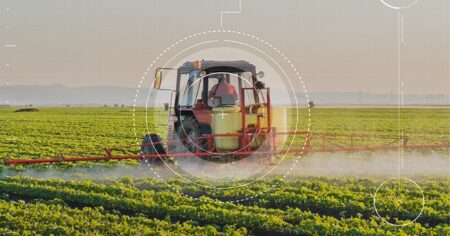How well your implements perform this spring is determined by your devotion to remedial maintenance. The following is an inspection repair tip list created by Kevin Kimberley, a farm operations consultant in Iowa, based on his field experience.
Mechanical Inspection
Hitch and Frame
Beginning with the hitch and walking your way to the rear, examine the frame by scrutinizing welds — particularly at hinges — for cracks, as well as for twisted or bent steel, and worn or loose fasteners and their bushings. “Catch and correct these problems in the shop before they break in the field,” Kimberley said.
Hydraulics
Inspect all hydraulic hoses, as well as their fittings, couplers, and cylinders, for leaks, wear, and cracking. Replace hoses, fittings, and cylinder seals as needed. Hydraulic leaks, in particular, compromise the ability of an implement to maintain tillage depth or to remain level in operation.
Tires
The single most overlooked item on implements, tires need to be examined for wear, weather cracking, and proper inflation. Also, spin them by hand while you watch for smooth rotation, and listen for bearing wear. “Now is the time to replace worn bearings rather than after you’ve gone out in the field and could possibly score a spindle in the process,” Kimberley said.
Soil-Engaging Tools
Any part that engages the soil must be checked for wear. Start at the front of the implement and examine disks or coulter blades (if you’re using a field-finishing implement) to ensure edges are sharp. Next, check for wear on sweeps, shovels, and points. Pay particular attention to those items running behind tractor tires, as they wear the fastest.
Once the point on a sweep is worn down, it can’t penetrate the ground; Kimberley compares it to using a butter knife versus a steak knife. Worn sweeps also smear the soil, creating a hard pan, and are less effective at breaking up big clods. Dull disks are worse because they compact soil by pushing, instead of cutting into the ground. Blunt blades can lift an implement out of the ground, often increasing draft by 15%–20% or more, causing a tractor to consume more fuel.
Disk blades can be sharpened; Kimberley recommends replacing wavy or rippled coulters.
Shanks
Often ignored, shanks and their mountings exert a major influence on sweep and shovel performance. Study all shanks to see if they are twisted, and shake them up and down and side to side to determine how worn their fasteners and related bushings are.
“Check springs and their mountings for elongation and lost tension,” Kimberley said. “Mounting bolts and spring cups, retainers, and washers do wear and break.”
Finishing Attachments
Inspect finishing attachment frames and mounting points. “Such attachments are crucial to leveling fields and distributing residue, which has a huge impact on
planter performance,” Kimberley said.
Check soil-engaging components for wear. “Coil tine length is particularly critical to how well they perform,” he said. “Pay close attention to tines or spikes, if so equipped, at the front of the ranks, as they wear the fastest.”
Regarding rolling baskets, the key is to appraise their bearings for smooth rotation; examine the baskets for bent rods or bars.
Lights
Engage all hazard lights, and replace bulbs and worn wiring. “If lack of lights causes an accident, the least of your concerns will be if you can even find a replacement implement before the season is over,” Kimberley said.
JamesBrey, Getty Images
Field Adjustments
You need to make daily adjustments to spring tillage equipment, Kimberley said. Also, never assume a new implement is properly adjusted.
“As a rule,” Kimberley said, “double-check adjustments whenever conditions change, whether it’s an alteration in soil type or residue coverage, such as when changing fields, or soil moisture as the day progresses and fields dry out.” The ultimate goal is to have an implement delivering even tillage from side to side and front to back.
Common symptoms of failing to meet this goal are the swales and ridges left behind. “Beyond these undulations causing row units to bounce, you are leaving strips of soft seedbed where sweeps ran deep, or hard pan where they failed to till,” Kimberley explained. “Uneven tillage leaves trails that can be seen a month later in uneven seed emergence.”
Kimberley also offered another crucial adjustment tip: “Always have two people involved with the process. Have one person run the tractor, and the second person [drive] alongside the implement, checking its performance while it is operating,” he said. “With the size of today’s equipment, you really can’t do much of a job checking an implement’s performance from inside the tractor cab. Besides, the best time to check an implement’s performance is while it’s operating.”
Leveling
It is vital that implements run level, not only side to side but also front to back.
“I can’t overemphasize what a huge impact level tillage operation has on planter performance,” Kimberley said.
Begin the leveling process by checking the stopped implement in the ground. To make this job easier, Kimberley uses wire ties to attach a plastic level to the front and side of the implement.
After making initial leveling adjustments, check for level operation while running in the field.
“This is crucial, as an implement can change inclination when running,” Kimberley said. “Make sure to check for level operation throughout the season.”
Hitch adjustment, particularly on implements with floating hitches, also requires attention. And often overlooked is leveling of finishing attachments, which, if left running askew, is the leading cause of trash windrowing and bunching, according to Kimberley.
Operating Depth
First, examine actual operating depth, by digging into the field in several locations across the implement’s entire width, and by digging down to the bottom of disks or sweeps with the implement at rest but still in the soil.
“I have often found tillage depth at the wings is not the same depth as at the main frame, which could indicate a leaky hydraulic cylinder or low tire,” Kimberley said. “I also insist that all my clients use chains that hang off the front corners of their implements, so they check depth on the go as well.” Such leveling chains run 4 inches off the ground to provide the tractor operator a quick check of running performance.
Kimberley said he prefers to have finishing implements set to evenly distribute trash on the surface. “Leave as much trash on the surface, where a planter’s trash wheels can sweep it out of the way for the double-disk openers,” he advised.
Sweep Operation
Kimberley said he prefers to see the shanks on sweeps vibrating when they operate. If a sweep is not moving, you smear and compact the soil underneath it. Also, active sweeps are far more effective at breaking up surface clods.
Finishing Attachments
In addition to double-checking that attachments are operating level, also determine if their full widths are making complete contact with the soil.
“This is your last chance to break up clods, level out the surface, and distribute residue, all of which has an influence on planter operation,” Kimberley said. Coil tine attachments that fill with trash, and rolling baskets that leave a bunch of trash behind are sure signs that the attachment is not operating level.
If your attachments are adjustable, don’t be content with remaining at one operation angle for the season. “There’s a good reason manufacturers make these things adjustable,” Kimberley said. “Evaluate the operating angles to suit changing field conditions, particularly as fields dry out.”
J Gouin, Getty Images
Speed
Kimberley said he prefers to run spring finishing implements, particularly field cultivators, fast. “I tell my clients to run cultivators at 8–8½ mph,” he said. “Doing so generates more tillage vibration through the sweeps and helps explode the soil, reducing clods. Faster speeds help distribute trash.”


:max_bytes(150000):strip_icc()/6895915516_c5d91051e4_o-dcfd56ad94744fe7a21a73a4193bf43a.jpg)
:max_bytes(150000):strip_icc()/BloombergContributor-2213407471-950399016ccb4e73ab5886ad1d623b2e.jpg)



:max_bytes(150000):strip_icc()/7021193JamesBrey-965529276_preview-920ab06c770e4375ba712bb382ec1a3f.jpg)

:max_bytes(150000):strip_icc()/For-Sale-Farmland-Natalina-Sents-Bausch-d53037fe10b24b288740b5a3089aa5c7.jpg)
:max_bytes(150000):strip_icc()/adm-1-ee7f0c8ca6d74828a32b170d601c90c5.jpg)
